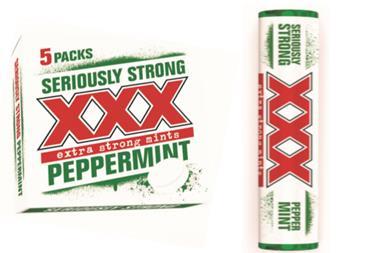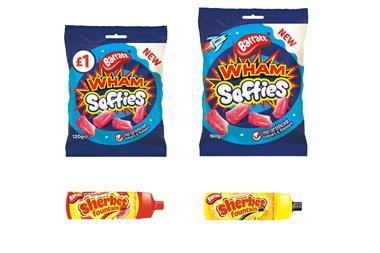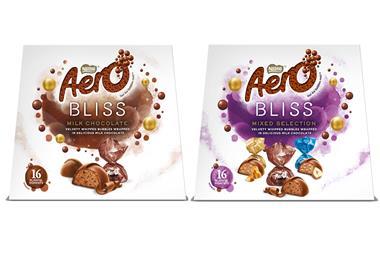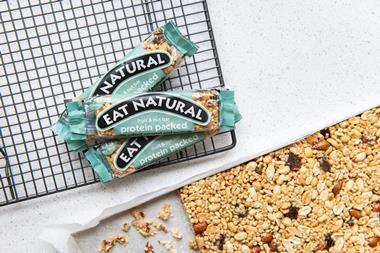Pricemarked chocolate and candy sharing formats still reign supreme, but retailers ignore the growing number of healthier lines at their peril.
Despite talk of the UK’s need to reduce obesity and cut down on sugar consumption, confectionery continues to perform.
“Confectionery is a strong category – it sells no matter what time of year or day,” says Francesca Barnard, shop assistant at Budgens Codford St Mary in Wiltshire.
In fact, confectionery is worth an appetising £6.3bn, with value growth of 1.9%, says Storck UK.
“Confectionery remains in the top four purchases within the convenience channel, only ranking behind the everyday essentials of bread, milk and soft drinks, so is a category that retailers cannot ignore,” points out Perfetti Van Melle trade marketing manager Mark Roberts.
This will come as no surprise to Harj Gill, Windmill Select & Save in Birmingham. “Confectionery is massive for us,” he says. “Sales are up by between 5% and 8%.”
Sales of the sweet stuff are also soaring at McLeish Inverurie in Aberdeenshire. “We’re about 3% up on confectionery,” says owner Scott Graham. He attributes this growth partly to npd, including Nestlé’s salted caramel Kit Kat Chunky and Mars Wrigley’s Maltesers Buttons.
Also driving growth are pricemarked packs (PMPs). “We’re finding pricemarked packs are working exceptionally well, predominantly the £1 hanging bags across chocolate and jellies. People want the larger packs for the value,” says Scott.
“Again, the larger £1 size of Galaxy and Dairy Milk are higher sellers than your standard bar of chocolate. A large percentage of our confectionery sales come from workmen and school children and without doubt they’re picking that up over anything else. If you look at a Dairy Milk countline, they’re about 80-85p and you’re getting something twice the size for £1. We’re certainly making less margin on the £1 blocks, but the volumes more than make up for that. If we didn’t have them, people would go elsewhere for them.”
It’s a similar story at Budgens Codford St Mary. Francesca says: “We have £1 pricemarked bags of Buttons, Twirl Bites and Twister Bites and they’re really quick sellers. We’re always ordering those.”
PMPs are a winner for Naresh Gajri at One Stop Cranhill Convenience Store, Glasgow. “The big bars sell well when they are pricemarked at £1,” he says. “We sell bags of Bonds sugar confectionery at three for £1, too.”
Harj also reports strong sales of £1 PMPs: “With chocolate bars, people have gone from countlines to £1 bars.
“The £1 bars of Cadbury Dairy Milk – Oreo, Daim, Fruit & Nut – are big sellers, plus Aero, Milky Bar, Nestlé Crunch, Galaxy and Galaxy Caramel.
“We stock Buttons, Maltesers and M&Ms £1 bags. Sales of bags have increased a lot since the £1 bags were introduced. The margins on these are lower than pouches, but what you make in sales outweighs the pouches’ better value. We have a local cinema so lots of people come in to get their snacks.”
He notes that the Big Night In occasion boosts sales at the weekend. “Young kids buy confectionery on the way to school, and at the weekend we see an uplift in sales from 5pm when people are having a night in watching a movie.”
Lauren George, brand and trade PR Manager at Mars Wrigley Confectionery UK says: “The rise in popularity of the Big Night In occasion has resulted in sharing pack PMPs playing an increasingly key role in the confectionery market.
“PMPs reassure shoppers they are getting the best value for money and provide the perfect chocolate treat for nights in with friends and family. They’re also a great way for retailers to grow sales in store and attract the attention of customers.”
Mars Wrigley claims that its £1 Galaxy block lines have seen impressive growth in recent months, with the Galaxy Milk Chocolate block valued at more than £200m. “With so many price-conscious shoppers today, pricemarked packs reassure them that they are getting the best value for money,” says George.
Mondelez International concurs. “Sharing is a key trend, as consumers look for products that are ideal for the Big Night In or family sharing occasion,” says Susan Nash, trade communications manager at Mondelez International. “Tablets play a big role in the sharing trend and are in growth (up 3.7% YTD). The chocolate bags segment is also key to sharing.”
Earlier this year Mondelez introduced new size £1 promotional pricemarked packs within its chocolate bags range, helping retailers to improve price perception among their shoppers and increase speed of sales and customer trust. The new £1 95g promotional PMPs are now available across some of its best-selling bags.
Blockhead secures distribution in symbols
Sugar-free energy gum brand Blockhead has announced the addition of three new partnerships with major national retailers MFG, Booker Retail Partners, and Costcutter, as well as new listings with 21 university outlets across the UK, including University College London and Warwick university.
Danny Lowe, founder & director at Blockhead, says:
“There has been a substantial shift in consumer attitudes towards the confectionery category, especially at point of sale, which are transforming and focusing more on promoting healthier products. This creates an exciting opportunity for Blockhead products because we fit both the functional and healthy option category.
“The better-for-you alternatives are continuing to grow in popularity, with new technology easily matching flavours, making functional products tastier therefore suiting the health conscious consumer. As a new category of product, we want to be the number-one alternative for consumers who want to have a gum with the benefits of fresh breath and energy, but also be a healthy option.
“The additional retail partnerships are testament to the quick consumer buy-in of Blockhead and the function it serves.”
Power of a pricemark
Another format that can sell well with a £1 flash is chocolate bar multipacks. “We have lots of chocolate blocks for £1 and the bagged sweets at £1, plus multipacks that have an rrp of £1.49 which we sell for £1 – for example, four-packs of Toffee Crisps and three-packs of Drifters,” says Mohammed Aslam of Wallyford Day Today Supermarket in Edinburgh.
However, pricemarked multipacks are a double-edged sword for some retailers. “We need to be really careful as retailers because when they [suppliers] brought out the three- and four-bar multipacks for £1, it cannibalised our core range,” says Scott. “Where we do stock that format we’re a lot more selective about it and we don’t give it as much space as we used to. It was taking away from sales of higher margin products. People see four for £1 and think it’s great, but you have to watch because it can have a significant impact on your margin.
“If you have a 2m fixture of single lines and a metre of four-packs beside it, then the savvy customer is going to pick up the four-pack where you’re only getting 20-25%, whereas on one bar you’re getting 40-45%.
“It’s hard to get an equal mix. We still stock the product, but not as many variants as we used to. We had a metre bay with five or six shelves, now we give it three. It’s workmen who tend to buy the multipacks. I think they use it for various occasions throughout the day – one for break time, one for lunch and one for an afternoon snack.”
While some people don’t have any qualms about tucking into three chocolate bars a day, a rising number of consumers are looking for more permissive snacks. “It escapes no one that sugar has received a lot of attention in the past year,” says Perfetti Van Melle’s Roberts. “Combine this with more health-conscious consumers and the environment could be seen as challenging. However, the category is in growth and such activity has also brought innovation to the sector, giving consumers even more choice.”
The government is now focusing heavily on sugar, supported by Public Health England, which is looking to reduce sugar in the UK’s diets. “Reduced and sugar-free confectionery products are key to supporting this impulse category,” says Roberts.
He claims that the Better For You (BFY) market is worth £44m MAT and is growing 11.9% (IRI 15 September 2018). “Research is already showing that 73% of sales in BFY are incremental to the category; implying people who previously may not have considered confectionery are entering the category,” Roberts adds.
Reducing the sugar
Displaying a range of sugar-free and sugar-reduced products among classic sugar lines, clearly signposted, helps consumers make a conscious choice when selecting their purchase, advises Roberts. The success of Fruit-tella’s reduced-sugar and sugar-free lines has resulted in the brand growing 19% to a value of £20m MAT.
“With Scotland going on about obesity targets, it makes perfect sense for suppliers to be looking at reduced-sugar products,” says Scott. He hasn’t had any customer requests for reduced-sugar confectionery, however he has had success with the BFY Fruit-tella lines. “We have stocked a reduced-sugar Fruit-tella product, but only because it was on promotion through the wholesaler. It sold out and we have kept it on as part of our hanging bag range.”
Haribo has also been busy coming up with BFY options. “The key trend for 2018 focuses on delivering more consumer choice,” says trade marketing manager Claire James. “This has seen an increase in sugar-reduced products, and a focus on formats – in particular smaller portion-controlled packs.”
The firm introduced Fruitilicious at the start of 2018. With 30% less sugar, the product boasts a lower sugar content per 100g than any of the category’s top 25 selling hanging bags. The company claims that the sweets are over-indexing with pre-families (consumers, aged 15-35, who have no children), families without children and households with one or two people.
Haribo says the product’s sales are more than double that of any other 30% less sugar brand. Furthermore, one in six shoppers return to purchase a second pack of the product within 12 weeks, delivering a higher repeat purchase rate than many top 10 products and the strongest of any 30% reduced-sugar treat, claims the firm.
Premium confectionery can help retailers remain competitive
Price promotions, particularly in the major supermarkets, are a strong feature in the confectionery market, but convenience retailers can counter this by strengthening their ranges with premium products, claims PWBrands, the team behind Epic Snax.
“Interestingly, premium confectionery is benefitting from ‘mindful’ consumption,” says director Jason Beaumont. “That means if a shopper decides to buy confectionery, they are often not considering price, but a host of other factors, from the quality of ingredients to the convenience of the packaging and always bearing in mind the occasion they are buying for.”
He adds that when it comes to premium sharing products in particular, health is not a key consideration for most consumers. “Sugar is regularly billed as the enemy, but we know that premium brands made with quality ingredients are still very much in demand from consumers,” he says. Epic’s range includes American Style Giant Toastin’ Marshmallows, Mini Marshmallow Chunks and Dippin’ Trays and Real Australian Soft Eating Liquorice. “These products are often bought for sharing occasions when people want to indulge a little. Health is not a factor they think about on these occasions,” says Beaumont.
“We’re seeing no drop-off in sales – in fact quite the opposite. People understand that sugar confectionery such as marshmallows and liquorice contain sugar, are happy to treat themselves and more likely to buy premium products that offer a point of difference, instead of a health benefit.”
With winter fast approaching, he encourages retailers to embrace the opportunity. “Now the nights are drawing in, more indulgent, sharing confectionery really comes into its own and we’d encourage retailers to really offer shoppers a strong, premium range to make the most of shoppers’ desire for something different.”
Chocolate evolution
Over in chocolate, manufacturers are also striving to create healthier variants. This summer Mondelez announced that Cadbury Dairy Milk will be available in a new bar with 30% less sugar.
“With the knowledge that options for balanced diets must be achieved without compromising on taste, a team of 20 scientists, nutritionists and chocolatiers have been working for almost two years to find a way to achieve the much-loved Cadbury Dairy Milk taste while delivering 30% less sugar, with no artificial sweeteners, colours or preservatives and no increase in calories,” says trade communications manager Susan Nash.
Also jostling for space within BFY chocolate are Gnaw’s 35g chocolate & granola bars (rrp 99p). Marketed as having 35% healthy ingredients, fibre makes up to 14% of each bar.
“There is a growing awareness around health and the impact the food we eat has on our bodies,” says founder Matt Legon. “While ‘being good’ is great, consumers are still reluctant to lose their sweet tooth completely and they won’t need to.”
There are three granola & seed bars in the range: milk chocolate with peanuts; milk chocolate with cranberries and raisins; and dark chocolate with orange. “The response to the new 35g chocolate & granola bars has been astounding, and surpassed expectation,” says Legon.
Storck UK has also come up with a healthier alternative to the traditional chocolate bar. “People are leading increasingly busy and health-conscious lifestyles, with factors such as long working hours, school runs and everyday errands filling up their days, and they are constantly on the lookout for a convenient snack that offers a better choice to most confectionery products, while providing that pick-me-up to keep them going for the rest of the day,” says managing director Andy Mutton.
The firm’s Knoppers bar (rrp 50p for a single and £1.25 for a four-multipack) is a multi-layered confectionery product, which the company says offers consumers “the chance to enjoy a light, sweet treat without the guilt of heavier confectionery”.
Size matters
In addition to product reformulations and npd, suppliers are also providing smaller pack sizes of popular products in a bid to provide healthier options.
“Within total confectionery sweets are one of the stronger performing sub-categories, growing value at 2.2%, success attributed in part to consumers buying smaller packs, more often,” says James at Haribo.
“Haribo’s introduction of smaller-sized packs has been hugely successful, with multipack minis commanding 64% of this growing market. This is why the brand continues to put the spotlight on mini bags in its ‘little bags of happy’ TV campaign.”
Following suit, Tangerine Confectionery has launched a new range of multipacks designed to target the family market with portion-controlled mini bags of classic favourites. The four ‘Bag of Bags’ multipacks each contain 11 mini bags of the same variety. These include Shrimps & Bananas (176g) and children’s favourites Mini Bears (198g) and Jelly Beans (165g).
Building on the popularity of milkshake-flavoured sweets, Tangerine is also launching strawberry Milkshake Bottles in a multipack format (176g) as well as a 180g hanging bag. “These will offer a modern twist on the popular milk bottle sweet with a strawberry flavour – a taste that has grown in popularity by 37% year on year, according to IRI,” says marketing and category director Russell Tanner.
The mini bags contain less than 65 calories per bag and have been designed to take advantage of the increased demand for the ‘bag of bags’ multipack format, currently growing in market share by 13% year on year, according to Kantar.
This growth has been driven by parents looking to portion control their children’s treats, as well as adults who are looking for a low-calorie on-the-go snack, states Tangerine.
Tanner adds: “We recognise that many consumers are trying to monitor the amount of sugar they consume and offering options that cater to these needs is a key driver for our new product division.
“Mini bags offer a controlled way to enjoy popular sweets and are perfect for families looking for pre-portioned treats for children, or adults looking for a calorie-controlled sweet snack.”
As time goes on, it is likely that we will see more healthier options enter the market in the form of smaller portions, npd, or reduced sugar. “It’s something I can understand will grow as we’ve seen an increase in diet- and lower-sugar soft drinks so there’s no reason we shouldn’t see that across confectionery as well,” says Scott.
“You just need to look at the growth in cereal bars. People have moved five or six years ago from buying a Mars Bar and now buying an Eat Natural bar. And some people are willing to pay £2 for a Mars Protein bar, versus 65p for a standard chocolate bar.”
However, while ensuring you make room for BFY lines is essential, it is clear that there is still an overwhelming demand for traditional chocolate and sweets. “My view is always that we are not in the position to dictate to the consumer,” says Scott. “We need to give them a choice. The position that we need to be in is where we offer a range of solutions.”
Mechandising: Secondary siting tips from Storck UK
• Make sure you include confectionery in your meal deal offering. Consumers love to feel as
though they’re getting a bargain and often will want a sweet treat with their savoury
sandwich or pasta and refreshment.
• Be aware of where you display confectionery. Placing confectionery closer to the exit will increase impulse purchases and encourage customers to buy them at the last minute. Often
if shoppers are unsure if they want something they will buy it just in case, particularly if they
can grab it on their way out
• Do you have a hot drinks machine? A variety of confectionery products go great with a hot cup of tea or coffee as a mid-morning or afternoon snack.
Placing product here will encourage those who are making a hot drink to pick one up to
accompany their refreshment
• Branded free standing display units are an easy way of placing product wherever you want in your store, particularly by a hot drinks machine where it may be difficult to have shelving. Merchandiser
strips are another convenient way of doing this and make product stand out and easily
accessible to customers































No comments yet